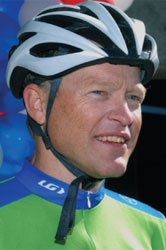
|
|
About Continuum Advertising Advisory Committee Archives Contact Us Continuum Home Faculty/Staff Subscribe related websites Alumni Association Marketing & Communications University of Utah Home |

GazetteNews of the UniversityCampus NotebookNew Center Created at College of Social and Behavioral Science The College of Social and Behavioral Science has established the Barbara L. and Norman C. Tanner Center for Nonviolent Human Rights Advocacy. The center will pursue nonviolent human rights advocacy on the interpersonal, community, and global levels through the education and participation of students, faculty, staff, and the greater community. Currently, the center is supporting research fellowships and the U’s undergraduate minor in Peace and Conflict Studies. The center will be directed by Ted Wilson, former Salt Lake City mayor and former director of the U’s Hinckley Institute of Politics. Beckerle Selected to Head HCI University of Utah biologist Mary Beckerle has been selected as the new executive director of the University’s Huntsman Cancer Institute (HCI). Beckerle was previously HCI’s deputy director and senior director of laboratory research. A faculty member at the University of Utah since 1986, Beckerle is also a professor of biology and adjunct professor of oncological sciences. Powerful Attraction The University recently completed work on the David M. Grant NMR Center, a $14 million facility that initially will house most of the University’s existing nuclear magnetic resonance (NMR) devices, which contain magnets that generate fields at least 35,000 to 212,000 times stronger than Earth’s magnetic field. Via a method known as nuclear magnetic resonance spectroscopy, these extremely powerful magnets will facilitate the study of large chemical molecules by researchers campuswide, including those in biology, medicine, biochemistry, chemistry, geology, chemical engineering, physics, materials science, and other fields. New Humanities Building In The Works In September, the College of Humanities conducted a site dedication and groundbreaking for the new Carolyn Tanner Irish Humanities Building, scheduled for completion in May 2008. The 55,000-square-foot facility will be the hub of the many departments, programs, and centers of the College of Humanities. In MemoriamRonald Peter King, retired professor of metallurgical engineering in the College of Mines and Earth Sciences. Robert H. Lamb, M.D., former assistant clinical professor of orthopedic surgery at the University of Utah School of Medicine. Joseph Smith Peery BS’35, retired University of Utah professor and business school dean. Milton Arthur Voigt, former University of Utah professor of English literature and dean of the College of Letters and Sciences. AccoladesThe University of Utah is on the Princeton Review's "Best 361 Colleges in the Nation" list for 2007. The U of U is named among the "Best in the West" and a "Best Value College," designating it one of the best overall bargains - based on cost and financial aid - among the most academically outstanding colleges in the nation. Yihua "Bruce" Yu, assistant professor in the U's College of Pharmacy, has received a Presidential Early Career Award for Scientists and Engineers, the U.S. government's highest award for indepedent researchers in the early stages of a career. KUED received eight 2006 Emmy Awards from the National Academy of Television Arts and Sciences, resulting in 12 Emmy statues for staff members - the greatest number ever presented to the University of Utah's public broadcasting station in one year.
Heart of CampusThe A. Ray Olpin Union Building turns 50 in January. by Randy Harward
But some of the reminiscences of the Union that stand out most sharply are from times when the building has served as a gathering place for reflection during momentous, historical events. “I remember walking into the cafeteria the day JFK was shot,” says Burton, “and there was complete silence.” Throughout 2007, the Union will feature commemorative displays and highlight reminiscences of U alumni. Festivities will kick off on January 17 with a birthday and rededication celebration, followed by a scholarship gala dinner on January 18. Utah Supreme Court Rules in Favor of State on Gun IssueIn September, the Utah Supreme Court ruled against the University in the lawsuit involving guns on campus. This resolves the University’s state law claims in the suit that was initially filed in federal court. The University’s policy prohibits faculty, staff, and students from carrying firearms on campus. In a 4-1 decision, the Utah Supreme Court ruled: “The University is subject to Utah law prohibiting it from enacting or enforcing any policy restricting the possession or use of firearms.” Current Utah law allows those with a concealed weapons permit to carry firearms into most locations in the state. In a statement released shortly after the ruling, the University said, “Our only goal from the beginning has been to keep our students safe. Universities across the country uniformly prohibit guns on campus.” Although the state law issues have now been resolved, issues remain before the Utah Federal District Court. However, the University and the Utah Attorney General’s Office jointly requested a stay in the federal action so that the parties, working with state leaders, can attempt to resolve the case through a legislative accommodation. Working with the Attorney General’s office, the University agreed to temporarily suspend enforcement of its policy regarding firearms on campus and modify its practices to comply with state law. In a message President Michael K. Young sent to University faculty, students, and staff, he stressed that the University remains committed to maintaining “a safe environment for students, faculty, staff, and patients.” |
Research RoundupResearchers have long known that those who tend to vote can be determined by three characteristics—education, age, and residential stability—and that the more you have of each, the greater the probability of voting. But U of U researcher Nicholas H. Wolfinger, associate professor in the Department of Family and Consumer Studies, has found a fourth consideration: an individual’s family structure, defined as marital status and the presence (or absence) of children in the household. Using a U.S. Census Bureau survey of more than 74,000 people to explore the effects of family structure on turnout in the 2000 presidential election, Wolfinger and his father and co-author, Raymond E. Wolfinger of the University of California, Berkeley, found that nearly three-quarters of married people voted, compared with just over half of singles. The study discovered that “vulnerable social groups”—notably single parents—are light voters and therefore may be proportionately underrepresented in policy making. University of Utah scientists have shown how evolution works by reversing the process, reconstructing a 530-million-year-old gene by combining key portions of two modern mouse genes that descended from the archaic gene. The study was conducted by Mario Capecchi, Distinguished Professor and co-chairman of Human Genetics at the U’s School of Medicine and an investigator with the Howard Hughes Medical Institute, and postdoctoral fellow Petr Tvrdik. The ability to reconstruct an ancient gene from descendant genes also raises the possibility of a new type of gene therapy, in which a portion of a related gene could be inserted into a disease-causing mutant gene to restore its normal function and cure the disease.
Unconventional WisdomWho: Peter Hoogenboom Hometown: St. Peter, Minn.; Salt Lake City Resident since 1985 Hoogenboom, an information technology and computer specialist with University Health Care, recently completed a 10,000-mile, 7-month, 48-state bike tour of the United States to raise awareness about diabetes. Hoogenboom, now 47, was diagnosed with diabetes at age 14. What is the best advice you’ve ever received? “I don’t recall who said this first, but I’ve heard both Lance Armstrong and Bob Roll (another professional cyclist) say it: Pain is temporary, but quitting is forever. I kept this in mind during my bicycle tour. There were times when it was difficult: the heat, the humidity, the exhaustion of being on the bike day after day, but the ‘quitting is forever’ part kept me going.”
|
 Katharine
Coles PhD'90, an associate professor of English, was named
Utah's new Poet Laureate in October. She has published two novels and
three collections of poetry. Her most recent collection of poems, Fault,
will be published in 2008. Coles will serve a five-year term of
office and act as the leading public advocate for the literary arts
in Utah.
Katharine
Coles PhD'90, an associate professor of English, was named
Utah's new Poet Laureate in October. She has published two novels and
three collections of poetry. Her most recent collection of poems, Fault,
will be published in 2008. Coles will serve a five-year term of
office and act as the leading public advocate for the literary arts
in Utah.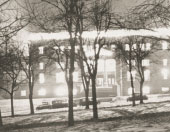 More
than 50 years ago, then director of the Union Building Douglas A. Woodruff
aimed to construct a new building and expand its facilities. On his
list of desired accoutrements were bowling lanes, billiard and ping-pong
tables, record-playing booths, and an art gallery, movie theater, reading
room, and ballroom. The new structure—later christened the A.
Ray Olpin Union Building, named for the president of the University
(1946 to 1964)—was unveiled in January 1957.
More
than 50 years ago, then director of the Union Building Douglas A. Woodruff
aimed to construct a new building and expand its facilities. On his
list of desired accoutrements were bowling lanes, billiard and ping-pong
tables, record-playing booths, and an art gallery, movie theater, reading
room, and ballroom. The new structure—later christened the A.
Ray Olpin Union Building, named for the president of the University
(1946 to 1964)—was unveiled in January 1957. 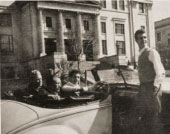 In
2007, the Union marks five decades as the heart of the U: a place to
eat, shoot pool, post roommate-wanted ads, and discuss ideas. But, regardless
of what happens under the Union’s roof, the building’s role
as the central meeting place for the U community is perhaps its most
important legacy.
In
2007, the Union marks five decades as the heart of the U: a place to
eat, shoot pool, post roommate-wanted ads, and discuss ideas. But, regardless
of what happens under the Union’s roof, the building’s role
as the central meeting place for the U community is perhaps its most
important legacy.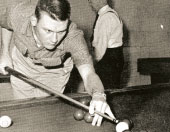 That
kind of open, democratic atmosphere has allowed the Olpin Union to become
a junction where students meet to express ideas, such as via debate
or protest—as when students staged a sit-in demonstrating against
the Vietnam War in the late 1960s—and in other gatherings to support
causes they believe in—as when the Grateful Dead performed in
1970 as a fundraiser for the Students for a Democratic Society. The
Union is also noted for spurring intellectual debate through its distinguished
list of noteworthy speakers. Martin Luther King, Jr., Madalyn Murray
O’Hair, Margaret Thatcher, Bobby Kennedy, and Spiro Agnew, among
others, have graced the ballroom’s stage.
That
kind of open, democratic atmosphere has allowed the Olpin Union to become
a junction where students meet to express ideas, such as via debate
or protest—as when students staged a sit-in demonstrating against
the Vietnam War in the late 1960s—and in other gatherings to support
causes they believe in—as when the Grateful Dead performed in
1970 as a fundraiser for the Students for a Democratic Society. The
Union is also noted for spurring intellectual debate through its distinguished
list of noteworthy speakers. Martin Luther King, Jr., Madalyn Murray
O’Hair, Margaret Thatcher, Bobby Kennedy, and Spiro Agnew, among
others, have graced the ballroom’s stage.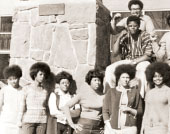 Yet
it’s not the famous speakers that most U students recall. Most
wax nostalgic about individual experiences, with the Union serving as
a backdrop. “I remember when they put the first video game in
the basement, Space Invaders,” says Steven Backus BFA’81.
“You would have to stand in line to play during the day, so I
would come in late at night and play until they kicked me out.”
Ken Burton BA’66 MFA’71 remembers games of a less technological
sort. “ ‘The Huddle’ was the place in the Union where
you could get a 10-cent cup of coffee (5 cents for a refill),”
he says, “and we would talk and play Hearts until it was time
to go to class, then someone would step in and pick up your hand, and
the game and the conversations would carry on.”
Yet
it’s not the famous speakers that most U students recall. Most
wax nostalgic about individual experiences, with the Union serving as
a backdrop. “I remember when they put the first video game in
the basement, Space Invaders,” says Steven Backus BFA’81.
“You would have to stand in line to play during the day, so I
would come in late at night and play until they kicked me out.”
Ken Burton BA’66 MFA’71 remembers games of a less technological
sort. “ ‘The Huddle’ was the place in the Union where
you could get a 10-cent cup of coffee (5 cents for a refill),”
he says, “and we would talk and play Hearts until it was time
to go to class, then someone would step in and pick up your hand, and
the game and the conversations would carry on.”
